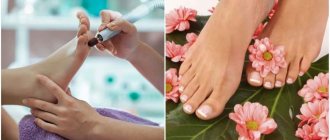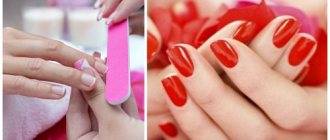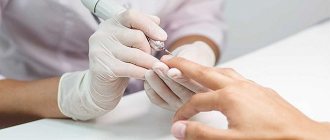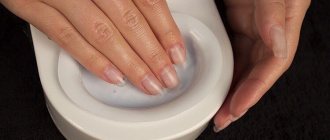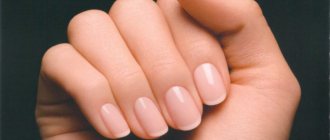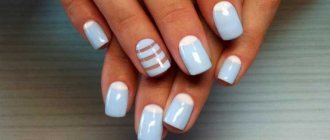How to insert and secure the attachment in a manicure machine?
It is important for a novice master to carefully study how to correctly insert a cutter into a manicure machine, since the serviceability and service life of the device and attachments directly depends on this.
There are 3 types of devices with different methods of attaching cutters:
- Automatic: fixation occurs immediately after placing the attachment in the clamp. The nuance of this type of fastening is that either a cutter or a plug must always be in the clamp, since otherwise it may close. It can only be opened at a service center.
- Semi-automatic: fixation takes place in 3 stages. First you need to turn the handle, then open the lock, insert the cutter and close the clamp.
- Manual: the easiest way to attach. To do this, you need to press the button located on the body of the device, remove the washer and insert the cutter. Perform the steps in reverse order - secure the washer and press the button.
Important. Professionals say that all fixation methods are reliable, but the most convenient are manual and semi-automatic.
Next, you can watch a video on how to insert the cutter into the machine:
Handle gets very hot
There are several reasons for this, the most obvious being improper use. If you use the device at high speeds for a long time, the rotor will subsequently overheat and the mechanism itself may melt, so you need to give the device a “rest.” If this does not help, then the problem is with the bearings: they are either defective, or not suitable for operation at high speeds, or were installed incorrectly when replacing the handle. It happens that the craftsmen contact service centers, and these bearings are simply lubricated, assuring them that the work should improve. Remember that bearings are consumables that need to be replaced! After working with lubricated bearings, you risk saying goodbye to the pen forever. Do not spare money on more expensive and high-quality materials, this will save you a lot of money on repairs in the future.
- Vibration in the handle when working with a cutter
- Vibration during operation of poorly centered cutters, that is, curved cutters
Cutters quite often become crooked after being dropped or used for a long time, and they are also damaged by the action of disinfectants and sterilization at high temperatures. Sometimes even in stores you come across damaged cutters, so always check them when purchasing. It is clear that curved cutters should no longer be used in work.
- Do all manicure cutters vibrate, even new and undamaged ones?
Yes, this also happens. But the point is not in the cutters, but in the clamping mechanism of the cutter - the collet. It also fails due to improper use. Only a specialist at the service center can determine the condition of the collet and replace it.
How to remove it to change it?
Removing the attachment from the manicure machine is as easy as inserting it. The method for removing the cutter directly depends on the type of attachment in the manicure machine:
- with the manual method, press the button on the body, unscrew the washer and remove the cutter;
- with the semi-automatic method, you need to turn the handle clockwise until it clicks and remove the nozzle;
- With the automatic fastening method, the cutter can be pulled out only after turning off the device; to do this, you just need to pull it towards you.
It is important to remember that with the automatic type of fastening, the clamp should not be empty; it must contain either a nozzle or a plug.
What is a hardware manicure?
This procedure does not require the use of conventional tweezers and scissors. Such instruments are replaced by a special apparatus with many attachments. This is a kind of milling machine, but only in reduced sizes. This device can perform several tasks at once, because it is capable of:
- Remove rough skin on hands and feet.
- Remove the dried skin layer on the side rollers of the fingers.
- Remove hangnails.
- Treat the cuticle.
- To sharpen, grind and polish the surface of the nail plates.
Possible problems: how to change it if it’s stuck, why can’t I put it on and something else?
Sometimes, when changing the attachment on a manicure machine, problems may arise. Some of them can be solved independently, and sometimes only a service center specialist can help. Solutions depend on the cause. The most common include:
- Breakage of the cutter. Perform the steps required to remove the attachment. Then shake the handle slightly so that the fragment can come out on its own by inertia. If it remains in place, you should disassemble the clamp and remove the rest of the attachment. You can try gluing the cutter using superglue.
- The nozzle is stuck. There may be several reasons - an incorrectly selected cutter, a broken clamp or motor, clogging, and others. You can only fix the blockage yourself; in other cases you will need the help of a specialist.
- The cutter is not fixed. The main reason is that the cartridge is clogged with biological waste (nail dust or shavings). To fix this problem, you will need to unscrew the cartridge and carefully clean it of dust using a brush. If this does not help, then the collet mechanism should be changed.
Attention! When solving the problem of changing a cutter yourself, it is recommended to photograph each step. Otherwise, you can assemble the mechanism incorrectly, which can lead to more serious damage.
Cutters for hardware manicure for beginners
Milling cutters vary in material, shape, diameter and hardness.
For beginners, it is recommended to use ceramic tips. They are quite soft, which means they are safer. But there is also a drawback - such cutters quickly become unusable.
Experienced craftsmen use diamond bits. With their help, you can treat the free edge of the nail, side ridges and cuticles, and remove rough skin.
Milling cutters come in various shapes. Each of them is intended for a specific area of work, but many can replace each other:
- “olive”, “bud”, “oval” - used to remove cuticles and treat side ridges;
- “ball” and “flame” also cope with this task;
- a “needle” is needed for treating cracks and side ridges, for rounding the corners of the nail, as well as for removing gel polish;
- a straight and truncated cone helps remove detachments and smears of gel polish, and also polishes and grinds well;
- a reverse cone, in addition to the above, creates a smooth edge of the nail;
- rounded cylinder - designed for processing side ridges and polishing the nail before extensions;
- straight cylinder - for modeling the free edge of an artificial nail, treating calluses and corns.
The hardness of the nozzles is determined by the colored notches that the manufacturer applies to the base. The classification principle is simple: the darker the color, the higher the hardness. It is not difficult to guess that the black and blue stripes will mean a high degree, and the red and yellow ones will mean a low degree.
During the procedure, we recommend using hard attachments first, gradually moving to medium and soft ones.
The small diameter of the attachments is intended for manicure, and the large diameter is intended for use during the pedicure procedure: with the help of such cutters it is easy to remove calluses, corns and other aesthetic imperfections on the feet.
Planet Nails, Manicure and pedicure device Orbita Smart
Manicure and pedicure device for treating nails.
(154)
RUB 11,050
RUB 11,050 Buy
Milv, Watermelon Nail Oil, 15 ml
Strengthening nail oil with mastic tree resin.
(17)
200 rub
200 RUR Buy
How to clean to use?
Almost all cutters are designed for reusable use and therefore require careful care, the first step of which is cleaning of biological material. It is carried out in different ways:
- Manually. The nozzle is cleaned with a brush (brass or plastic) under running water. The simplest, but at the same time the most energy-consuming method, most often used at home.
- In an ultrasonic sterilizer. Rinse the nozzles under running water and place them in the device so that they do not come into contact with each other. This method is not suitable for all types of cutters, so before use, be sure to study the care recommendations for each of them.
- Dental cleaning apparatus. Just as in the previous method, the cutters need to be rinsed under running water. Then set the temperature in the device to 90 °C and place the attachments in it for 5 minutes.
Regular cleaning can not only significantly extend the life of attachments, especially corundum and steel ones, but also prevent the spread of infection.
Below is a video about cleaning cutters:
How to disinfect?
The next mandatory step in caring for cutters is their disinfection. To do this, use 2 methods:
- physical - ultraviolet or ultrasonic treatment, boiling, calcination;
- chemical – aging in special disinfectants.
Reference. The use of chemicals requires certification and strict adherence to instructions, so they can only be used in a salon environment.
At home, it is better to give preference to the physical method of disinfection. To do this, keep the cutters in an oven heated to 180 °C for 20 minutes or boil for 15 minutes.
How to sterilize?
The final stage of processing of cutters is sterilization, chemical (used only in salons) and hardware. There are several types of devices designed for hardware sterilization:
- glasperlene devices, in which processing occurs by heating to 230 ° C and takes 30–180 seconds;
- autoclaves are sterilized with hot steam for 15–40 minutes;
- dry-heat ovens process instruments at a temperature of 180–250 °C for 30 to 120 minutes.
Treated cutters should be stored in a sterile, hermetically sealed container.
At what speed should it work?
To perform a manicure using the device efficiently and painlessly, it is important to know at what speed it should operate at each stage of the procedure.
Important! When cleaning the pterygium and opening the cuticle, the optimal speed is 15,000–17,000 revolutions; for cutting, depending on the skin type, 5,000–8,000 revolutions.
There are also speed recommendations depending on the type of cutter:
- “flame” shape with red notch – 10,000–15,000 rpm;
- corundum – 7,000;
- “corn” shape – 30,000 in FWD mode;
- for polishing – 5,000–7,000.
To quickly learn how to perform a manicure using a device, it is important not only to know the technique of the procedure, but also all the nuances of working with it. A responsible approach to training will help you gain the necessary experience and client base in a short time.
Step-by-step instruction
If you have already acquired a device and cutters, we recommend researching tips on how to properly do a hardware unedged manicure at home:
- The procedure is carried out only on a dry plate. Otherwise, the plate will begin to heat up, which will cause some discomfort. In addition, the plots will be treated worse;
- If a composite or customizable unit is used (for example, Strong), then it is necessary to set the cycle frequency to a speed of up to 10,000. If it is higher, then you will easily erase your nails due to the lack of proper skill;
- Do not press the clipper close to the nail or, especially, put pressure on it while working;
- The first few times you need to practice on silicone tips. Then, when working with rough cutters, you will know how to hold them correctly, at what angle and how long.
Instructions and special technology for performing hardware manicure step by step:
For a better understanding, we recommend watching a video master class from experts on how to do a hardware manicure.
Video training for beginners on how to do a hardware manicure Video


